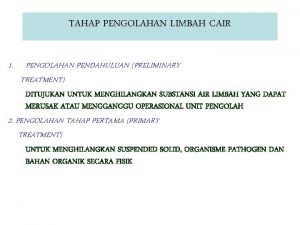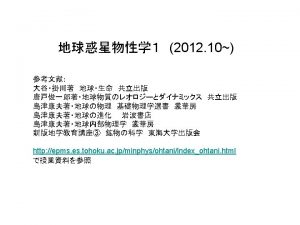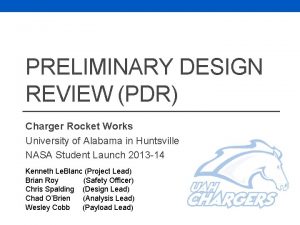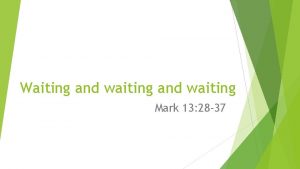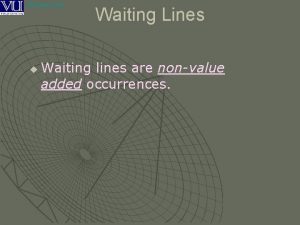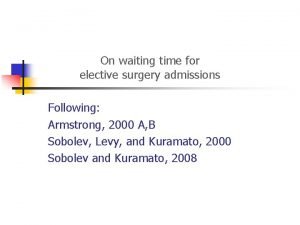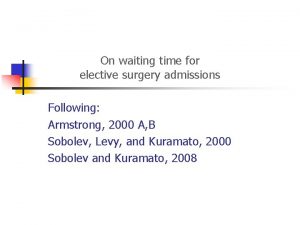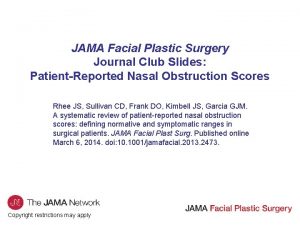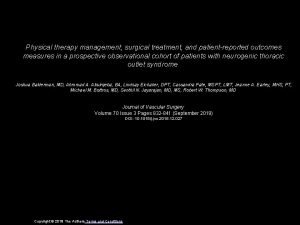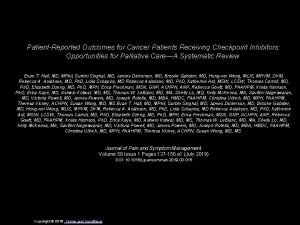PatientReported Outcomes and Waiting for Elective Surgery Preliminary
















- Slides: 16

Patient-Reported Outcomes and Waiting for Elective Surgery: Preliminary Findings Jason M. Sutherland Centre for Health Services and Policy Research University of British Columbia The Taming of the Queue Appropriateness and Accountability April 4, 2014

Disclosure The research presented today is funded by: • Canadian Institute for Health Research (CIHR) • Vancouver Coastal Health Authority (in-kind) Approved by: • University of British Columbia Behavioural Research Ethics Board • Vancouver Coastal Health Authority Privacy Office

Spending Annual % change in total health and hospital spending, 1981 -2012 Source: CIHI, CMS National Health Expenditure Historical Data

How are we doing? Canada Norway Sweden Australia UK France New Zealand Netherlands USA Switzerland Germany 0% 5% 10% 15% 20% waited 4 months or more for elective surgery 25% 30% 35% 40% 45% waited 2 months or more for specialist apt Commonwealth Fund 2013

What is missing? Collect and measure patient-reported outcomes • Completed by patients • Standardized, validated questionnaires • Measure self-perceived quality of life, functional well-being and health status • Generic or condition-specific

Self-reported health on the wait list Methods Elective surgery – Measure patient’s reported outcomes prospectively – Evaluate changes in patients’ health over time

Where do we collect PROs?

Self-reported health on the wait list Methods • 7 specialties; 6 hospitals in metro Vancouver region Response Rate: 44% • Entering wait list: 45 % • Just before surgery: 68 % 13% 12% er y 2% s y eu r rth O os ur g op ed ic ro lo g ar yn go to l G 5% U y y co lo g s Pl as tic yn e O G en er al Su rg er y 7% N 16%

Self-reported health status EQ-5 D Five domains: 1. 2. 3. 4. 5. Mobility Self-care Usual activities Pain / discomfort Anxiety / depression AND A ranking of overall health status

Self-reported health EQ-5 D

Self-reported pain Three domains: 1. Intensity of pain 2. Pain interference in enjoyment of life 3. Pain interference with general activity

Self-reported depression Two domains: 1. Symptoms 2. Functional impairment

Self-reported health What does a patient’s self-reported health tell us at the start of their wait time? 1. Aspects of health are very good: • Usual activities • Function and Mobility 2. Largest potential for improving patient’s health: • Anxiety / Depression • Pain

The wait and self-reported health

Self-reported health What does patient’s change in self-reported health over the wait time tell us?

Advancing world-class health services and policy research and training on issues that matter to Canadians www. patientreportedoutcomes. ca www. chspr. ubc. ca @CHSPR
 Generic elective academic writing and composition
Generic elective academic writing and composition Aberdeen electives
Aberdeen electives Pamagat ng teksto simula gitna o katawan konklusyon
Pamagat ng teksto simula gitna o katawan konklusyon Art elective programme
Art elective programme College preparatory elective examples
College preparatory elective examples Elective ict
Elective ict Haleine énolique
Haleine énolique Shower approach marketing
Shower approach marketing Preliminary cooking and flavoring
Preliminary cooking and flavoring Preliminary budget
Preliminary budget Preliminary treatment adalah
Preliminary treatment adalah Preliminary survey audit
Preliminary survey audit P 波
P 波 Preliminary design review example
Preliminary design review example Preliminary materials
Preliminary materials Preliminary outline example
Preliminary outline example Preliminary interview
Preliminary interview










